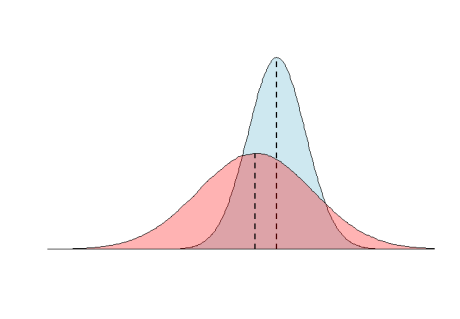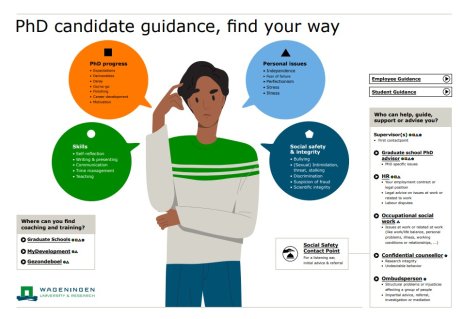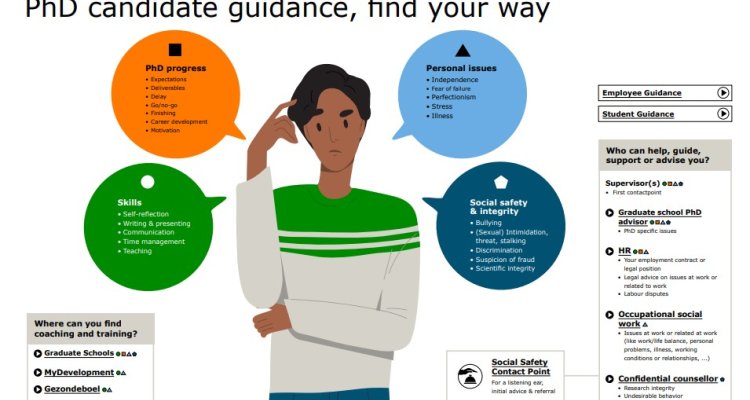
Burnout
WIAS Magazine – Summer edition 2024
Lifestyle
Burnout is a topic that seems omnipresent yet not talked about enough. Most of us have seen colleagues disappearing for a few months due to the mental burden of everyday life becoming too much. The main goal of this article is to increase awareness and ensure people in WIAS can form a supportive network in which the incidence of burnout is something we're aware of, and something we actively try to prevent.
What is a burn out?
Burnout can be divided into multiple stages; most images on the internet divide burnout into 12 stages leading up to a burnout (figure 1). These stages are generally a chronological process, ranging from hard work to prove your worth, to a full mental and physical collapse which leads to long periods away from work and having to relearn how to attempt work in a healthy way. Consider the difference between being overworked and burnout. You can feel overworked and chronically stressed (developing ‘surmenage’) if there is high work pressure and you continue to overburden yourself instead of taking rest when necessary. If the state of surmenage lasts too long without proper de-stressing, this can lead to burnout. Burnout requires a longer recovery period than surmenage, and is considerably heavier.
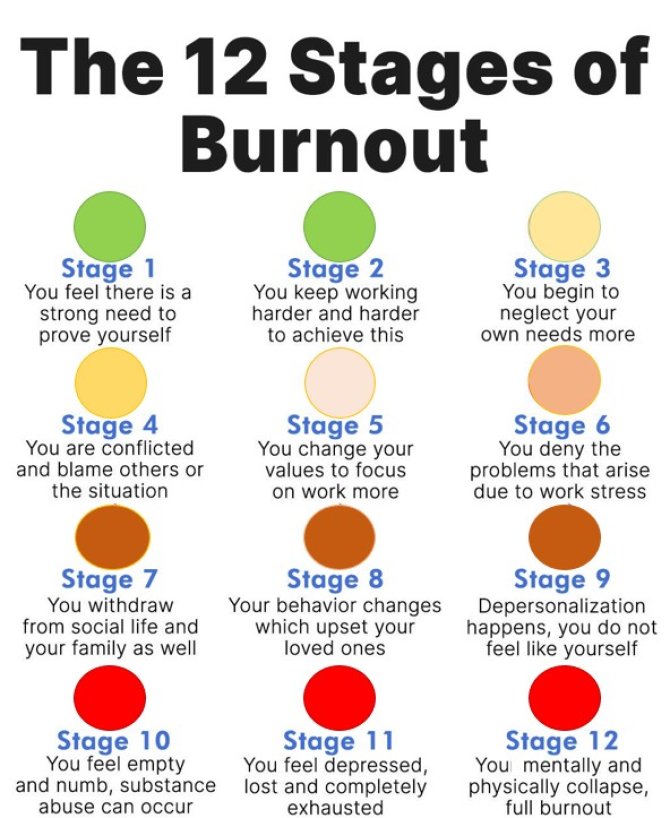
Figure 1 The 12 stages of burnout as commonly described on the internet. Be aware the first stages are not burnout, but lead to surmenage and, if this continues too long, full burnout.
Incidence
A study by Golembiewski et al. in 1998 showed pretty shocking numbers on burnout. They estimated 40% of the workforce (main focus on the US and Canada) to be in the advanced stages of a burnout (1).
Many other studies into the incidence of burnout focus on medical professionals, from dentists to nurses and anesthesiologists. Due to the long working hours and emotional pressure, healthcare professionals are likely to experience (symptoms of) burnout. This does not mean people working in academia are safe. In a study in 2004 among 265 full-time university faculty members of one university, almost 20% of the faculty experienced the advanced stages of burnout (2). While this number is clearly lower than in the Golembiewski study, one in five faculty staff experiencing such levels of stress, emotional exhaustion and depersonalization is disheartening to hear.
A master thesis from the US found that almost 66% of graduate students in the US reported above-average stress, mainly due to poor relationships with supervisors and difficulty finding a good work-life balance (3). While exact data on burnout of graduate students in the Netherlands is difficult to find (most studies focus on biomedical/medical students), Wielers et al. show that in 2018 17.8% of Dutch workers in age range 15-34 years experienced burnout complaints (4).
Probably many of the graduate students and faculty in Wageningen have experienced burnout complaints at one time or another. If that is not the case, you will probably have seen a colleague or two disappear for some time due to a full-on burnout, or severe complaints associated with a burnout. It is and remains an important topic for all of us to be aware of.
But what to do if you experience symptoms?
While it is easy to tell people they should slow down, take some more rest and exercise to make sure they don’t experience burnout, this is easier said than done. Burnout is a complex phenomenon that does not only start because of work. Having family or friends that need help and support continuously can lead to burnout symptoms similar to those of work-related burnout (5). Furthermore, some of the literature reviewed in (5) links burnout to personality types. People who long for social approval are more likely to experience high stress and (symptoms of) burnout.
So, then what might help us reduce the incidence of burnout?
- Openness about stress and emotional complaints. Make sure people in your surroundings are aware of the pressure you are experiencing. Preferably you already tell people about your symptoms while you’re experiencing chronic stress and symptoms of being overworked.
- Receptiveness and awareness in our surroundings. An environment which does not expect perfection, or at least the very best on every day, can help people relax. Many burnout related complaints exist due to pressure and demands that are not internal, but external. Examples include the necessity to secure a permanent contract (so work harder to get the opportunity), a boss that lets people compete for assignments and projects and colleagues, family, friends and bosses that always ask for more, regardless of what you deliver.
- Willingness to change on both sides
Preventing burnout must come from internal and external signals. If you try to take care of yourself once you realize you're experiencing surmenage, but your surroundings keep on demanding more, you might still end up burned out.
What are things like in Wageningen?
As can be seen in figure 2, the main reason for help requests of Animal Science Group (ASG) employees at Occupational Social Work is due to stress and work-life balance, with re-integration coming third. Medium and long-term sickness absence at ASG is mainly due to psychological issues, probably including surmenage and burnout.
When comparing ASG and the WUR wide numbers (figure 3), we do see that there is a bigger percentage of employees of ASG requesting help from Occupational Social Work compared to the WUR average: 8 compared to 6 percent. However, based on both infographics, no clear conclusions on the incidence of surmenage and burnout can be drawn.
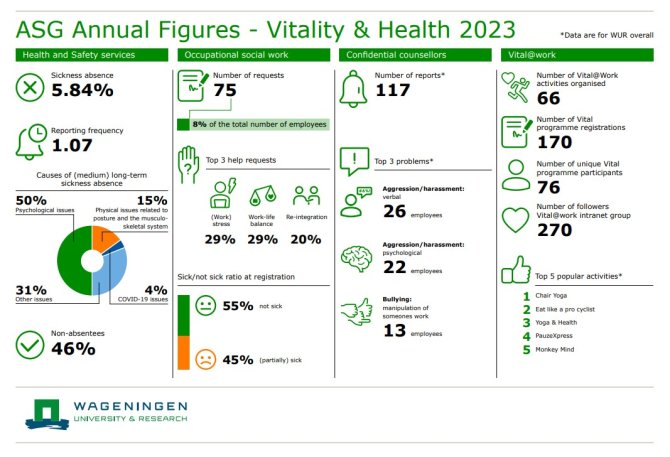
Figure 2 Statistics on vitality and health within the animal sciences group. The main help requests at the Occupational Social Work are related to stress and work-life balance. Note that the section about confidential councellors is based on WUR wide data and not just ASG data.

Figure 3 Statistics on vitality and health within WUR. The main help requests at the Occupational Social Work are related to stress and work-life balance.
It does seem there is awareness of surmenage and the risk of burnout within various chair groups within ASG, at least at the PhD level. While this is good, many questions remain unanswered. The incidence of burnout between contract and non-contract PhD students probably differs, and it would be important to have numbers or clear estimates on this to determine the root causes of surmenage and burnout among PhD students. Additionally, we are unsure whether there is a difference between the incidence of surmenage and burnout between PhD students and other employees.
For PhD students, it would be good to take a look at General and mental
guidance - WUR. This website contains a lot of information on who to contact in which situation, including in cases of work-life imbalances, chronic stress and burnout. The medical officer or Occupational Social Work can both be contacted to discuss chronic stress and surmenage, and how to (hopefully) prevent burnout. Online, there is also information available on stress and burn-out. The guidelines of the Dutch Society of General Practitioners (NHG) are very helpful. Unfortunately, these guidelines are written in Dutch (Overspanning en burn-out | NHG-Richtlijnen), making it more difficult for international students to understand these guidelines. Here the medial officer and Occupational Social Work can again help. Also take a look at figure 4. There might even be a printed version of this infographic somewhere in your office/building!

Figure 4 Infographic on who to contact in which case of problems that can be encountered during the PhD.
Awareness of the resources WUR provides can help prevent the development of burnout. If it feels to daunting to directly contact one of these offices or people, first try discussing your symptoms and fears with a colleague or friend you feel comfortable with. Hopefully, they will be able to help you find the help you need. And remember only if everyone is aware and willing to change the system, we can really change our work life for the better! Don't normalize working more than 40 hours a week, or consistently working weekends. You're not just hurting yourself doing this, you might also show BSc, MSc and other PhD students that overworking is normal, thereby setting an unwanted example.
Sources
- Estimates of Burnout in Public Agencies: Worldwide, How Many Employees Have Which Degrees of Burnout, and with What Consequences? on JSTOR
- Exploring burnout among university faculty: incidence, performance, and demographic issues - ScienceDirect
- Burnout in Graduate Students - D-Scholarship@Pitt
- Full article: Career insecurity and burnout complaints of young Dutch workers (tandfonline.com)
- Burnout: A Review of the Literature - Jessica Nápoles, 2022 (sagepub.com)




